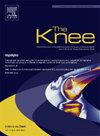髌股骨关节炎期间,肌生长抑制素通过上调Wnt/β-catenin通路诱导软骨下骨破坏和软骨基质降解
IF 2
4区 医学
Q3 ORTHOPEDICS
引用次数: 0
摘要
背景髌股骨关节炎(PFOA)的发病机制尚不完全清楚。本项目旨在探讨肌生长抑制素(MSTN)在PFOA发病中的作用和机制。方法15只新西兰大白兔随机分为3组:对照组、模型组和mstn诱导组。6周后进行组织病理学观察和破骨细胞染色观察。还评估了破骨细胞分化相关途径、软骨降解和细胞外基质沉积相关基因的表达。此外,我们还研究了巨噬细胞转染β-catenin过表达质粒对成骨细胞分化和RANKL和Smad2下游蛋白水平的影响。同时检测MMP-13水平以评估软骨退化程度。结果组织病理学检查观察到smstn诱导的髌股关节软骨下骨和软骨破坏,TRAP染色观察到破骨细胞增殖。样品中β-catenin、MMP-13、Smad2、RANKL的表达水平显著升高,II型胶原蛋白的表达水平显著降低。β-catenin过表达后,巨噬细胞中Smad2、RANKL和MMP-13的表达水平显著升高。结论smstn参与PFOA的进展,诱导髌股关节软骨下骨破坏和软骨基质降解,并通过上调Wnt/β-catenin通路促进破骨细胞分化。本文章由计算机程序翻译,如有差异,请以英文原文为准。
Myostatin induces subchondral bone destruction and cartilage matrix degradation through upregulation of the Wnt/β-catenin pathway during patellofemoral osteoarthritis
Background
The pathogenesis of patellofemoral osteoarthritis (PFOA) is not fully understood. The aim of this project was to investigate the role and mechanism of myostatin (MSTN) in PFOA pathogenesis.
Methods
Fifteen New Zealand white rabbits were divided into the following three groups: the control group, the model group and the MSTN-induced group. After 6 weeks, histopathological studies and osteoclast staining observations were carried out. The expression of genes related to osteoclast differentiation-related pathways, cartilage degradation and extracellular matrix deposition was also assessed. In addition, we investigated how macrophage transfection with a β-catenin overexpression plasmid affects osteoblast differentiation and downstream protein levels of RANKL and Smad2. MMP-13 levels were also detected to assess the extent of cartilage degradation.
Results
MSTN-induced subchondral bone and cartilage destruction in the patellofemoral joint was observed during histopathological examination, and osteoclast proliferation was observed via TRAP staining. The expression levels of β-catenin, MMP-13, Smad2, and RANKL were significantly increased, and the level of collagen II was significantly decreased in the samples. The expression levels of Smad2, RANKL and MMP-13 were significantly increased after the overexpression of β-catenin in macrophages.
Conclusions
MSTN contributes to the progression of PFOA, induces subchondral bone destruction and cartilage matrix degradation in the patellofemoral joint, and promotes osteoclast differentiation through upregulation of the Wnt/β-catenin pathway.
求助全文
通过发布文献求助,成功后即可免费获取论文全文。
去求助
来源期刊

Knee
医学-外科
CiteScore
3.80
自引率
5.30%
发文量
171
审稿时长
6 months
期刊介绍:
The Knee is an international journal publishing studies on the clinical treatment and fundamental biomechanical characteristics of this joint. The aim of the journal is to provide a vehicle relevant to surgeons, biomedical engineers, imaging specialists, materials scientists, rehabilitation personnel and all those with an interest in the knee.
The topics covered include, but are not limited to:
• Anatomy, physiology, morphology and biochemistry;
• Biomechanical studies;
• Advances in the development of prosthetic, orthotic and augmentation devices;
• Imaging and diagnostic techniques;
• Pathology;
• Trauma;
• Surgery;
• Rehabilitation.
 求助内容:
求助内容: 应助结果提醒方式:
应助结果提醒方式:


